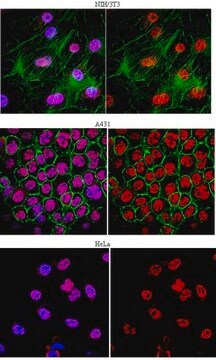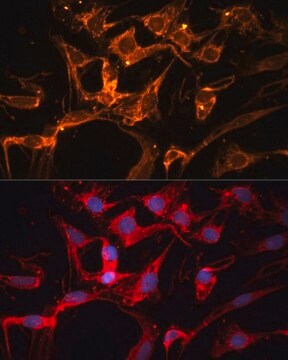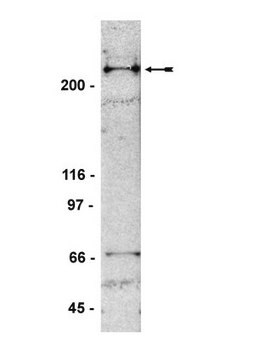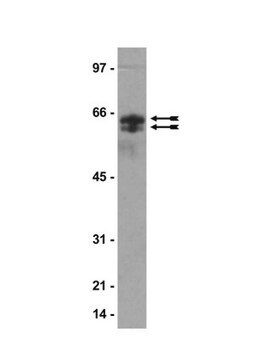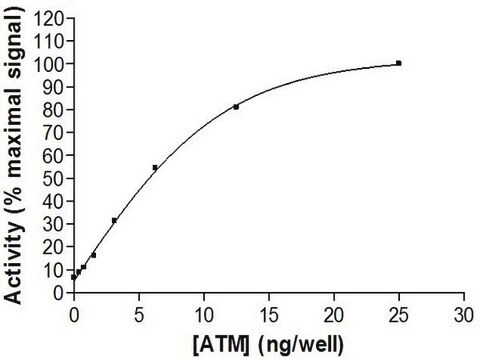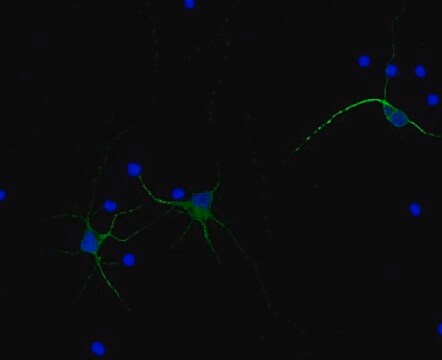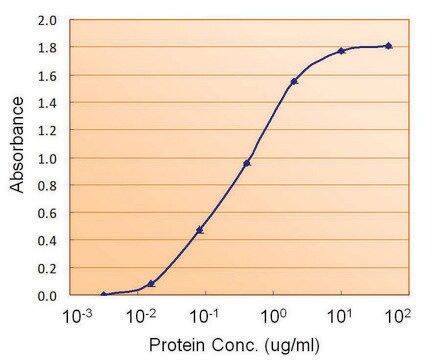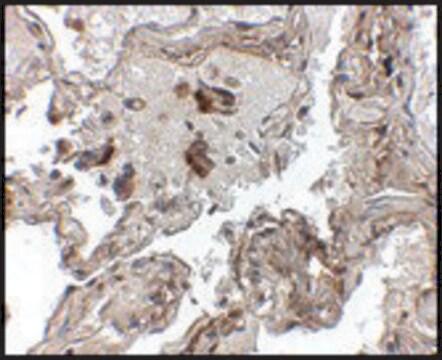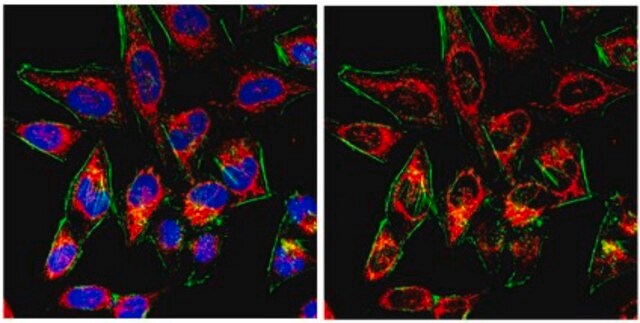05-1517
Anti-hnRNP Q Antibody, clone 18E4
clone 18E4, from mouse
동의어(들):
heterogeneous nuclear ribonucleoprotein Q-like, Synaptotagmin-binding, cytoplasmic RNA-interacting protein, Glycine- and tyrosine-rich RNA-binding protein, GRY-RBP, NS1-associated protein 1
로그인조직 및 계약 가격 보기
모든 사진(1)
About This Item
UNSPSC 코드:
12352203
eCl@ss:
32160702
NACRES:
NA.41
추천 제품
생물학적 소스
mouse
Quality Level
항체 형태
purified immunoglobulin
항체 생산 유형
primary antibodies
클론
18E4, monoclonal
종 반응성
human
기술
immunocytochemistry: suitable
immunoprecipitation (IP): suitable
western blot: suitable
NCBI 수납 번호
UniProt 수납 번호
배송 상태
wet ice
타겟 번역 후 변형
unmodified
유전자 정보
human ... SYNCRIP(10492)
일반 설명
Heterogeneous nuclear ribonucleoprotein Q commoly refered to as hnRNP Q can be found as three different isoforms derived from alternative splicing of a single gene. This RNA binding protein is implicated in control of mRNA precursor splicing for the survival of motor neurons (SMN) protein, a gene. Loss-of-function mutations of SMN are linked to spinal muscular atrophy (SMA) a common neurodegenerative disease. It has been shown that hnRNP Q proteins interact with SMN, and this is interacton is required for efficient pre-mRNA splicing in vitro. Current data suggests that hnRNP Q is a splicing modulator of SMN.
특이성
This antibody recognizes hnRNP Q.
면역원
Epitope: Unknown
Recombinant protein corresponding to human hnRNP Q.
애플리케이션
Immunocytochemistry
Cited by independent researcher using a representative lot.
Immunoprecipitation
Cited by independent researcher using a representative lot.
Cited by independent researcher using a representative lot.
Immunoprecipitation
Cited by independent researcher using a representative lot.
Research Category
Epigenetics & Nuclear Function
Epigenetics & Nuclear Function
Research Sub Category
RNA Metabolism & Binding Proteins
RNA Metabolism & Binding Proteins
Use Anti-hnRNP Q Antibody, clone 18E4 (Mouse Monoclonal Antibody) validated in WB, ICC, IP to detect hnRNP Q also known as heterogeneous nuclear ribonucleoprotein Q-like.
품질
Evaluated by Western Blot in HeLa cell lysate.
Western Blot Analysis: 1 µg/ml of this antibody detected hnRNP Q on 10 µg of HeLa cell lysate.
Western Blot Analysis: 1 µg/ml of this antibody detected hnRNP Q on 10 µg of HeLa cell lysate.
표적 설명
The calculated molecular weight is 70 kDa Clone 18E4 can recognizes four bands on the Western Blot of total HeLa cell lysate corresponding to molecular masses of ~80, ~70, ~60 and ~55 kDa hnRNP Q has three isoforms of ~70– 55 kDa The ~80 kDa reactive band was identified as hnRNP R, which migrates at ~80 kDa on SDS–PAGE. (Mourelatos., Z., et al., EMBO J., 20, 5443-5452 (2001).)
물리적 형태
Format: Purified
Protein G Purified
Purified mouse monoclonal IgGκ in buffer containing 0.1 M Tris-Glycine (pH 7.4, 150 mM NaCl) with 0.05% sodium azide.
저장 및 안정성
Stable for 1 year at 2-8°C from date of receipt.
분석 메모
Control
HeLa cell lysate
HeLa cell lysate
기타 정보
Concentration: Please refer to the Certificate of Analysis for the lot-specific concentration.
면책조항
Unless otherwise stated in our catalog or other company documentation accompanying the product(s), our products are intended for research use only and are not to be used for any other purpose, which includes but is not limited to, unauthorized commercial uses, in vitro diagnostic uses, ex vivo or in vivo therapeutic uses or any type of consumption or application to humans or animals.
적합한 제품을 찾을 수 없으신가요?
당사의 제품 선택기 도구.을(를) 시도해 보세요.
Storage Class Code
12 - Non Combustible Liquids
WGK
WGK 1
Flash Point (°F)
Not applicable
Flash Point (°C)
Not applicable
시험 성적서(COA)
제품의 로트/배치 번호를 입력하여 시험 성적서(COA)을 검색하십시오. 로트 및 배치 번호는 제품 라벨에 있는 ‘로트’ 또는 ‘배치’라는 용어 뒤에서 찾을 수 있습니다.
Fruzsina Hobor et al.
Nature communications, 9(1), 831-831 (2018-02-28)
Exosomal miRNA transfer is a mechanism for cell-cell communication that is important in the immune response, in the functioning of the nervous system and in cancer. Syncrip/hnRNPQ is a highly conserved RNA-binding protein that mediates the exosomal partition of a
Hye Guk Ryu et al.
Journal of neurochemistry, 149(3), 413-426 (2018-11-30)
Misfolded proteins with abnormal polyglutamine (polyQ) expansion cause neurodegenerative disorders, including Huntington's disease. Recently, it was found that polyQ aggregates accumulate as a result of vaccinia-related kinase 2 (VRK2)-mediated degradation of TCP-1 ring complex (TRiC)/chaperonin-containing TCP-1 (CCT), which has an
자사의 과학자팀은 생명 과학, 재료 과학, 화학 합성, 크로마토그래피, 분석 및 기타 많은 영역을 포함한 모든 과학 분야에 경험이 있습니다..
고객지원팀으로 연락바랍니다.